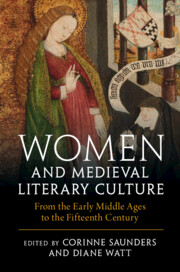Book contents
- Women and Medieval Literary Culture
- Women and Medieval Literary Culture
- Copyright page
- Contents
- Illustrations
- Contributors
- Acknowledgements
- Introduction
- I Patrons, Owners, Writers, and Readers in England and Europe
- II Circles and Communities in England
- III Health, Conduct, and Knowledge
- IV Genre and Gender
- Chapter 11 Lyrics
- Chapter 12 ‘It satte me wel bet ay in a cave / To bidde and rede on holy seyntes lyves’
- Chapter 13 Tears, Mediation, and Literary Entanglement
- Chapter 14 Convent and City
- Chapter 15 Women and Romance
- Chapter 16 Trouble and Strife in the Old French Fabliaux
- Chapter 17 Chaucer and Gower
- V Women as Authors
- General Index
- Index of Manuscripts
- References
Chapter 13 - Tears, Mediation, and Literary Entanglement
The Writings of Medieval Visionary Women
from IV - Genre and Gender
Published online by Cambridge University Press: 28 July 2023
- Women and Medieval Literary Culture
- Women and Medieval Literary Culture
- Copyright page
- Contents
- Illustrations
- Contributors
- Acknowledgements
- Introduction
- I Patrons, Owners, Writers, and Readers in England and Europe
- II Circles and Communities in England
- III Health, Conduct, and Knowledge
- IV Genre and Gender
- Chapter 11 Lyrics
- Chapter 12 ‘It satte me wel bet ay in a cave / To bidde and rede on holy seyntes lyves’
- Chapter 13 Tears, Mediation, and Literary Entanglement
- Chapter 14 Convent and City
- Chapter 15 Women and Romance
- Chapter 16 Trouble and Strife in the Old French Fabliaux
- Chapter 17 Chaucer and Gower
- V Women as Authors
- General Index
- Index of Manuscripts
- References
Summary
Liz Herbert McAvoyߣs essay on women visionaries highlights the importance of community in relation to womenߣs literary culture, in particular textual community. McAvoy adopts Karen Baradߣs terminology of dynamic intra-actions to describe the lives and writings of visionaries in the European high and later Middle Ages, taking as her starting point the complex and manifold spiritual female entanglements across space and time that are described in The Book of Margery Kempe. McAvoy traces such intra-actions back through Mechthild of Hackeborn and the nuns of Helfta in the thirteenth century to Hildegard of Bingen in the eleventh, and forwards to the later fourteenth century and Julian of Norwich. McAvoy also identifies the influence of Mechthild on A Revelation of Purgatory, written in the early fifteenth century by an anchoress of Winchester, and on the writings of Birgitta of Sweden, with which Kempe was familiar. McAvoy concludes that these interwoven spiritual connections between women are mirrored in knotted patterns of manuscript patronage and ownership.
Keywords
- Type
- Chapter
- Information
- Women and Medieval Literary CultureFrom the Early Middle Ages to the Fifteenth Century, pp. 269 - 284Publisher: Cambridge University PressPrint publication year: 2023



